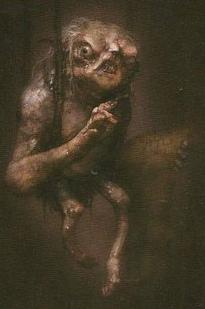- "Orc is not an English word. It occurs in one or two places [in The Hobbit] but is usually translated goblin (or hobgoblin for the larger kinds)."
- —J.R.R. Tolkien, Preface to The Hobbit
Goblins are what Tolkien called the Orcs that Thorin and Company encountered in the book The Hobbit. They lived deep under the Misty Mountains in many strongholds, ever since the War of Wrath in the First Age. In The Hobbit, Tolkien described them as big, ugly creatures, "cruel, wicked, and bad-hearted." Tolkien explained in a note at the start of The Hobbit that he was using English to represent the languages used by the characters, and that goblin (or hobgoblin for the larger kind) was the English translation he was using for the word Orc, which (he wrote) is the hobbits' form of the name for them. Tolkien used the term goblin extensively in The Hobbit, and also occasionally in The Lord of the Rings, as when the Uruk-hai of Isengard are first described: "four goblin-soldiers of greater stature".
A clear illustration that Tolkien considered goblins and orcs to be the same thing, the former word merely the English translation of the latter, is that in The Hobbit (the only one of Tolkien's works in which he usually refers to orcs as goblins) Gandalf asks Thorin if he remembers Azog the goblin who killed his grandfather Thror,[1] while in all his other writings Tolkien describes Azog as a "great Orc."[2]
Sometimes Tolkien did state a difference between Orcs and Goblins, sometimes using the word Gongs was used as well as a sub-type of Orc. In Peter Jackson's Film Trilogy Goblins and Orcs are different. However in The Fellowship of the Ring (film) Moria is full of Goblins but in the flashback in An Unexpected Journey it is swarming with Gundabad Orcs.
History and Description
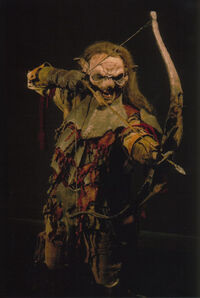
Goblin archer of Moria.
When Melkor was taken in chains to Valinor, the Orcs and other foul creatures were forced to flee from Angband. Their kingdoms spread throughout many mountains of Middle-earth; notable cities include Goblin-town near the High Pass above Rivendell, the Goblin-capital at Mount Gundabad, and the former Dwarf-kingdom of Moria, as well as those in the service of Isengard and Mordor.
Goblin Technology
Even though goblins are portrayed as a very barbaric and tribal race their technology seems to be more advanced than other races in middle earth. In the Hobbit, Tolkien describes goblins as having dark technology. In the chapter Over Hill and Under Hill Tolkien states "It is not unlikely that they invented some of the machines that have since troubled the world, especially the ingenious devices for killing large numbers of people at once, for wheels and engines and explosives always delighted them."
Weapons and armor
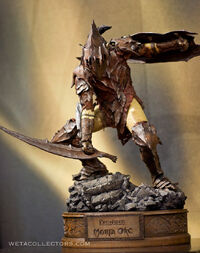
A heavily armed Goblin warrior
Goblin weapons include scimitars, axes, and spears, as well as bows. The great goblin-soldiers of Isengard, the fighting Uruk-hai, are distinguished by their use of short, straight swords and long bows of yew.
Portrayal in adaptations
In popular parlance, perhaps because the word goblins was used in The Hobbit (which was in many ways essentially a children's book), whereas orcs came across as more fearsome in Tolkien's later works, it has become common for many to distinguish goblins as different from orcs: smaller and less fearsome, or at least a smaller and less fearsome type of orc. This idea has gained currency through its widespread adoption in various adaptations of Tolkien's stories, as well as in many derivative fantasy worlds, including novels, movies, and games such as Dungeons & Dragons.
The Hobbit (1977 film)
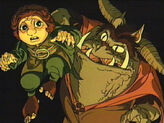
The strange beast-like Goblins from the 1977 film.
The animated Goblins appearing in this film are large, putrid green, bestial creatures. They are far bulkier than what one normally expects for a Goblin, being either hugely muscular or fat. They also had bulbous toad-like heads featuring tusks, lupine ears, canine-like noses, and even horns. Addionally, they are shown to be able to ride on wargs, which only orcs can do.
The Return of the King (1980 film)
This 1980 animated adaptation attempted to explain to viewers the identification of goblins with orcs. Early in the movie, Sam is heard thinking, "Orcs in the tower. Old Bilbo called them goblins. Whatever the name, I loathe the vile creatures." The Goblins/Orcs in this film use much the same design as those seen in The Hobbit, but with more variations in shape and size, and a more bluish skin tone.
The Lord of the Rings film trilogy
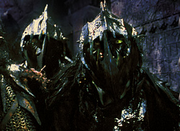
Scavenging Goblins
In the Peter Jackson movie The Fellowship of the Ring (2001), the Goblins have overrun the dwarven colony in Moria long before the events of the movie. When the Fellowship passes through the abandoned Dwarf city of Dwarrowdelf, Pippin accidentally alerts the Goblins to their presence, causing a fight to break out in the Balin's Tomb. In this instance, their main weapon appears to be a Cave Troll, which has to be brought down by the whole Fellowship, but the entire force is wiped out by the end of the battle.
However, the skirmish allows a much larger force of Goblins to close in on the Fellowship, who flee to the Bridge of Khazad-dûm. Unfortunately for them, even more Goblins intercept them in one of Dwarrowdelf's great halls, emerging from cracks in the floor and holes in the ceiling to aid their comrades. The Goblins were about to kill the Fellowship when they flee after sensing the Balrog Durin's Bane approaching.
Trapped in a sea of Goblins, the Fellowship could only prepare for death, but the evil creatures suddenly paused as a menacing roar echoed in the distance. As a distant hall lit with a fiery orange glow, the Goblins inexplicably fled in all directions, leaving the Fellowship to wonder at their fortune — as well as at what was coming next: Durin's Bane. In the book, Orcs are more effective fighters than in the film adaptation. It was an Orc chieftain who stabbed Frodo in the original story, rather than the Cave Troll shown in the movie, and Sam was also injured by another Orc. Haldir tells the Fellowship that Orcs will pursue enemies for long distances, even during the day, to avenge the death of a chieftain.
The Hobbit film trilogy
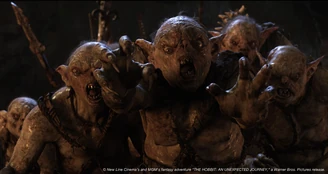
Goblins of the High Pass.
The Goblins of the High Pass seen in Peter Jackson's first installment of the Hobbit trilogy are quite different compared to the Goblins of Moria, having flesh-toned skin and riddled with various skin diseases and deformations like harelips, mismatched or skewed eyes, and crooked-growing fingernails. They are overall much more grotesque than Goblins seen in the Lord of the Rings trilogy, being as tall as any Dwarf or Hobbit. These types of goblins later appear in The Hobbit: The Battle of the Five Armies as "goblin mercenaries" adorned in armor with using Trolls.
Video games
List of Goblin units & Heroes
The Goblin's Image or their Dragon-War Mascot on the Final score in BFME II
- Goblin Warriors
- Goblin Archers
- Cave-troll
- Half-Troll Marauders
- Mountain Giants
- Fire-Drakes
- Spiderlings
- Goblin Spider Riders
- Wildmen of Dunland
- Corsairs of Umbar
- Half-Troll Swordsmen
- Warg-Riders
- Cave bats
- Ogre
- Hobgoblins
- Were-worms
- Fire Drake Brood
- Shelob
- Drogoth the Dragon-Lord
- Gorkil The Goblin-King
- Azog
Appearance
In the minds of many (though not in Tolkien's writings), goblins were of smaller build than other orcs, although "The Great Goblin" and "Azog the Goblin" (as they were called in The Hobbit) were massive in size.
In the Peter Jackson films, being of the same stature as dwarves and hobbits, the goblins are depicted in appearing to lead a much more tribal life compared to the orcs, often having a chief among smaller groups. Compared to orcs, goblins are less organized and use a vast range of scavenged items of clothing, armour and weaponry. They also have a fear of light and the sun and will not step out in daylight most of the time.
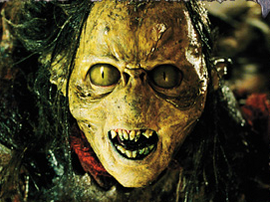
A goblin from Moria.
There are two varieties of goblins: The goblins of the Misty Mountain and the goblins of Moria. The goblins of the Misty Mountain have flesh-colored skin and seem to be afflicted with various skin diseases and deformations that include hairlips and stunted growth. The goblins of Moria have a very green-colored skin tone compared to their Misty Mountain cousins with larger pointier ears and huge bulbous eyes that reflect their nature as cave creatures.
|
Races of Arda
Ainur | Dwarves | Elves | Ents | Great Eagles | Hobbits | Huorns | Men | Petty-dwarves | Skin-changers (Beornings) Servants of the Shadow:
Barrow-wights | Ettens | Dragons (Fire-drakes and Cold-drakes) | Ogres | Orcs | Spiders | Trolls | Úmaiar | Úvanimor | Vampires | Wargs | Werewolves |
References
- ↑ The Hobbit, "an Unexpected Party".
- ↑ The Lord of the Rings, Appendix A.


